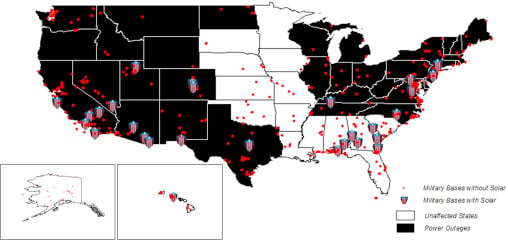J.M.Pearce (talk | contribs) m (→In the News) |
J.M.Pearce (talk | contribs) m (→In the News) |
||
| Line 36: | Line 36: | ||
* [https://electrek.co/2017/05/12/egeb-20-trillion-us-military-microgrids/ EGEB: $20T for climate change, military solar microgrids, 1,000 mile EV, more] - Electrek | * [https://electrek.co/2017/05/12/egeb-20-trillion-us-military-microgrids/ EGEB: $20T for climate change, military solar microgrids, 1,000 mile EV, more] - Electrek | ||
* [http://www.pbsionthenet.net/article/133354/Solar-to-combat-national-security-risks-in-the-power-grid.aspx Solar to combat national security risks in the power grid] - Panel, Building & System Integration | * [http://www.pbsionthenet.net/article/133354/Solar-to-combat-national-security-risks-in-the-power-grid.aspx Solar to combat national security risks in the power grid] - Panel, Building & System Integration | ||
---- | ---- | ||
| Line 43: | Line 43: | ||
* [http://techon.nikkeibp.co.jp/atcl/news/16/051507537/ 「太陽光マイクログリッド」で施設のレジリエンス向上] -- Nikkei Business Publications (Japan) (Google 818) | * [http://techon.nikkeibp.co.jp/atcl/news/16/051507537/ 「太陽光マイクログリッド」で施設のレジリエンス向上] -- Nikkei Business Publications (Japan) (Google 818) | ||
* [http://qianyancailiao.com/index.php?s=/cms/index/detail/id/474/cid/10.html 安装太阳能电池应对美国电网中存在的国家安全风险] -- Qianyancailiao (China) | * [http://qianyancailiao.com/index.php?s=/cms/index/detail/id/474/cid/10.html 安装太阳能电池应对美国电网中存在的国家安全风险] -- Qianyancailiao (China) | ||
* [http://oilprice.com/Energy/Energy-General/Solar-Mini-Grids-Could-Shield-The-US-From-Terrorist-Strikes.html#comment_added Solar Mini-Grids Could Shield The U.S. From Terrorist Strikes] - Oil Price , [http://en.iranenergy.news/news/renewable-energies/solar-mini-grids-could-protect-us-terrorist-strikes Energy Today (Iran)] | |||
* [http://www.energymatters.com.au/renewable-news/solar-photovoltaic-microgrid-system-protect-military-power-supply-em6040/ Solar Photovoltaic Microgrid System to Protect US Military Power Supply] - Energy Matters (Australia) | |||
{{Solar navbox}} | {{Solar navbox}} | ||
[[category:economics]] | [[category:economics]] | ||
Revision as of 10:56, 16 May 2017

Source
- Emily W. Prehoda, Chelsea Schelly, Joshua M. Pearce. 2017. U.S. Strategic Solar Photovoltaic-Powered Microgrid Deployment for Enhanced National Security. Renewable & Sustainable Energy Reviews 78, 167–175. DOI:10.1016/j.rser.2017.04.094 open access
Abstract
The U.S. electrical grid, the largest and most complex man-made system in the world, is highly vulnerable to three types of external threats: 1) natural disasters, 2) intentional physical attacks, and 3) cyber-attacks. The technical community has recommended hardening the grid to make it more resilient to attack by using distributed generation and microgrids. Solar photovoltaic (PV) systems are an ideal distributed generation technology to provide power for such microgrids. However, both the deployment velocity and the policy of how to implement such technical solutions have been given far less attention than would be normally considered adequate for a national security risk. To address this threat, this paper reviews the technical and economic viability of utilizing defense contracting for the beginning of a national transition to distributed generation in the U.S. First, the technical scale of electrical demand and the solar PV system necessary is analyzed in detail to meet the first level of strategic importance: the U.S. military. The results found that about 17 GW of PV would be needed to fortify the U.S. military domestically. The current domestic geographic deployment of microgrid installations in the critical U.S. defense infrastructure were reviewed and compared to historical grid failures and existing and planned PV installations to mitigate that risk. The results showed a minimal number of military bases have introduced solar PV systems, leaving large parts of the Department of Defense electrical infrastructure vulnerable to attack. To rectify this situation, the technical skills of the top 20 U.S. defense contractors is reviewed and analyzed for a potential contracting transition to grid fortification. Overall the results indicate that a fortified U.S. military grid made up of PV-powered microgrids is technically feasible, within current contractors skill sets and economically viable. Policy recommendations are made to accelerate U.S. military grid fortification.
Keywords
National security; Photovoltaic; Resilience; Microgrid; Defense; Distributed generation
See also
- Review of solar levelized cost
- Performance of U.S. hybrid distributed energy systems: Solar photovoltaic, battery and combined heat and power
- Emerging economic viability of grid defection in a northern climate using solar hybrid systems
In the News
- Installing solar to combat national security risks in the power grid - MTU News, Newswise, Eureka Alert, Phys.org, Science Daily, Lab Equipment Magazine, R&D Magazine, Anti-corruption Digest,Solar Thermal Magazine, PVBuzz, HiTech Days, Science Blog, Electrical Construction & Maintenance, Solar Daily, Topix, Arabian Post, Technology Breaking News, Renewable Energy World
- Solar Microgrids for National Security: Study Finds 17 GW Could Fortify US Military Bases - Microgrid Knowledge
- Shoring Up the Power Grid with Solar Photovoltaics - Engineering.com
- Solar panels could protect the military from attacks on the energy grid - Engineering and Technology
- U.S. researchers say solar micro-grids can help military facilities prevent cyber and physical threats - PV Magazine
- Study: Solar micro-grids can help military fight cyber, physical threats - PV Magazine USA
- Using solar to combat security risks in the power grid - EQ Magazine
- How Military Solar-Powered Microgrids Could Boost National Security - Solar Industry Magazine
- Solar power to reduce national security risks in the U.S. power grid Homeland Security News
- Michigan Tech study suggests outfitting military infrastructure with solar PV microgrid systems - Daily Energy Insider
- Michigan Tech Research: Solar Can Aid Military Security Affordably - Tech Century
- Solar Technology Can Help Secure Military Grids, New Paper Finds - Security Management
- EGEB: $20T for climate change, military solar microgrids, 1,000 mile EV, more - Electrek
- Solar to combat national security risks in the power grid - Panel, Building & System Integration
- Rischi per la sicurezza nazionale Usa dagli attacchi alla rete elettrica: la soluzione è il solare- Green Report (Italy)
- OZE na pomoc amerykańskim bazom wojskowym - Business Alert (Polish)
- 「太陽光マイクログリッド」で施設のレジリエンス向上 -- Nikkei Business Publications (Japan) (Google 818)
- 安装太阳能电池应对美国电网中存在的国家安全风险 -- Qianyancailiao (China)
- Solar Mini-Grids Could Shield The U.S. From Terrorist Strikes - Oil Price , Energy Today (Iran)
- Solar Photovoltaic Microgrid System to Protect US Military Power Supply - Energy Matters (Australia)





